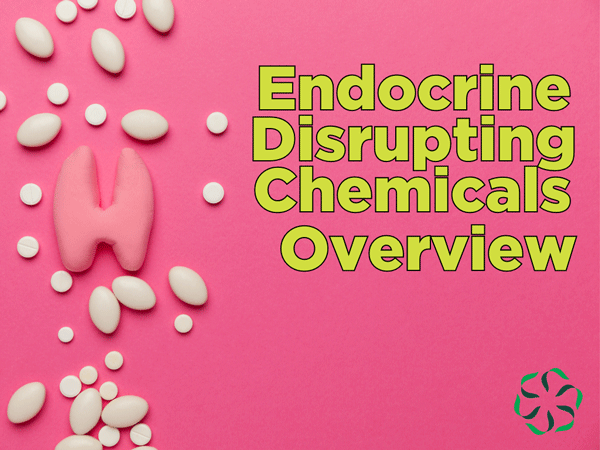In our last post, we reviewed the basics around our endocrine system and how our endocrine system functions. In this post, we’ll explore endocrine disrupting chemicals further.
What is an endocrine disrupting chemical?
Endocrine disrupting chemicals are compounds that can interfere with maintaining the appropriate balance of our hormones by altering the amount of hormone being made and transported, degrading the hormone quality, or by mimicking the biological action of a hormone.
Are all endocrine disrupting chemicals harmful?
No, endocrine disrupting chemicals, like many other chemicals, can be harmful, helpful, or neutral depending on the situation.
Endocrine disrupting chemicals like the kind found in prescribed pharmaceuticals can be incredibly beneficial to the recipient. In fact, in this context, the term endocrine disrupting is misleading and would be more appropriately termed “endocrine acting”.
However, endocrine disrupting chemicals such as contaminants found in large enough quantities that are not prescribed and monitored by a healthcare professional have the potential to cause harm to the body and we can face a number of adverse health outcomes such as reproductive health issues, cognitive deficits, obesity, and cancer (1).
Where do we find endocrine disrupting chemicals?
We can find naturally occurring endocrine disrupting chemicals called phytoestrogens in plants and foods such as beans, cabbage, grains, hops, lavender, spinach, sprouts, soybeans, and more which are safe to consume and use in moderation (1,2,3).
We find synthetic endocrine acting chemicals in regulated pharmaceutical medications including:
- Birth control medications
- Hormone replacement and regulation medications (e.g., insulin)
- Steroid medication
There are other endocrine disrupting chemicals that are the byproducts of industrial processes, are used to make everyday items, or are used in highly specialized processes (1):
- Dioxins — produced as a byproduct in herbicide production and paper bleaching, they are also released into the environment during waste burning and wildfires.
- Perchlorate — a by-product of aerospace, weapon, and pharmaceutical industries found in drinking water and fireworks.
- Perfluoroalkyl and Polyfluoroalkyl Substances (PFAS) — used widely in industrial applications, such as firefighting foams, paper, and textile coatings.
- Phthalates — used to make plastics more flexible, they are also found in some food packaging, cosmetics, children’s toys, and medical devices.
- Polybrominated diphenyl ethers (PBDE) — used to make flame retardants for household products such as furniture foam and carpets.
- Polychlorinated biphenyls (PCB) — banned in 1979, PCB was used to make electrical equipment like transformers, and in hydraulic fluids, heat transfer fluids, lubricants, and plasticizers and can still be found in old equipment.
- Triclosan — may be found in some anti-microbial and personal care products, like liquid body wash.
How do we evaluate the safety of endocrine disrupting chemicals?
As we’ve covered in previous blog posts (1,2,3), researchers use risk assessments to determine the safety and safe levels of exposure.
Scientists will use data to determine the highest level an animal can be safely exposed to a compound. Then to protect human health, researchers will use the safe dose observed in the animals and divide it by an uncertainty factor of 100 or higher to generate a safe level (1).
Regulatory agencies then use this safe level to guide policy-making decisions. This process helps ensure that the general public will not be exposed to the compound at unsafe levels.
The rationale underlying this risk-based approach is the fundamental principle of toxicology and underscored in the phrase, the dose makes the poison. As we discussed in previous blogs almost anything can be hazardous at a high enough dose (even water). However, if we’re not exposed to harmful levels, then there is no risk.
Rather than the risk-based approach, there are regulatory agencies that use what is called the “precautionary principle” when evaluating the safety of endocrine disrupting chemicals.
Some researchers have suggested that endocrine disrupting chemicals may not act like most known hazards and argued that even very small doses of endocrine disrupting chemicals can cause adverse health effects.
When regulatory agencies and scientists apply the precautionary principle to ingredient safety, it means an ingredient will not be approved if there is a concern that the ingredient could cause harm, regardless of the amount that people might be exposed to in everyday life.
Researchers are still exploring the ways our endocrine system may or may not be impacted by very small doses of endocrine disrupting chemicals and, as of this publication, they haven’t come to any definitive conclusions.
Are there new developments for evaluating endocrine disrupting chemicals?
In the United States, the Food and Drug Administration (FDA) and the Environmental Protection Agency (EPA) are using various technologies to facilitate the safety evaluation of ingredients that could potentially cause endocrine disruption (1,2).
The information gleaned from new high-tech tools helps the FDA and EPA make decisions regarding the levels of chemicals we can be exposed to safely. The regulatory agencies take appropriate steps to mitigate any risks caused by endocrine disrupting chemicals to help ensure the protection of public health and the environment.
The good news.
Established and new technologies used in combination with our ever-advancing knowledge of biology, allows us to better understand how ingredients can impact our health, including our endocrine health. Researchers continue to develop new ways to evaluate potential exposure risks.
As we learn more we can make better, more informed choices to benefit our health.

